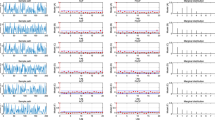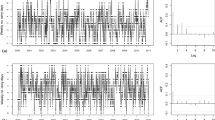Abstract
Count time series exhibiting seasonal patterns are frequently encountered in practical scenarios. For example, the number of hospital emergency service arrivals may show seasonal behavior (Moriña et al. 2011 Stat Med 30:3125–3136). Numerous models have been proposed for the analysis of seasonal count time series with an unbounded support, yet seasonal patterns in bounded count time series, which are sometimes suffered in environmental science such as the number of monthly rainy-days and air quality level data, have not received formal attention. The contribution of this article lies in coping with the modeling challenges associated with seasonal count time series with a bounded support, which is beneficial for enhancing the applicability of environmental science data. This is achieved by introducing a seasonal structure and seasonally varying model parameters into the first-order binomial autoregressive (BAR(1)) model (McKenzie 1985 J Am Water Resour Assoc 21:645–650). The probabilistic and statistical properties, marginal distribution and some special cases of the proposed model are studied. Estimation of model parameters is conducted using the Yule-Walker, conditional least squares and maximum likelihood methods. The asymptotic normality of the estimators is also presented. To demonstrate the utility of our model in environmental data, applications are carried out on the monthly number of rainy-days in two Russian cities.



Similar content being viewed by others
Data Availability
Data will be made available on request.
References
Al-Osh MA, Alzaid AA (1987) First-order integer-valued autoregressive (INAR(1)) process. J Time Ser Anal 8:261–275
Bentarzi M, Souakri R (2023) On periodic generalized Poisson INAR(1) model. Commun Stat-Simul Comput, Forthcom. https://doi.org/10.1080/03610918.2023.2205613
Freeland RK, McCabe BPM (2004) Analysis of low count time series data by Poisson autoregression. J Time Ser Anal 25:701–722
Góuveia S, Möller TA, Weiß CH, Scotto MG (2018) A full ARMA model for counts with bounded support and its application to rainy-days time series. Stoch Env Res Risk A 32:2495–2514
Jahn M, Weiß CH (2024) Nonlinear GARCH-type models for ordinal time series. Stoch Env Res Risk A 38:637–649
Kang Y, Wang D, Yang K (2020) Extended binomial AR(1) processes with generalized binomial thinning operator. Commun Stat-Theor Methods 49:3498–3520
Kang Y, Wang D, Yang K (2021) A new INAR(1) process with bounded support for counts showing equidispersion, underdispersion and overdispersion. Stat Papers 62:745–767
Kang Y, Wang S, Wang D, Zhu F (2023) Analysis of zero-and-one inflated bounded count time series with applications to climate and crime data. TEST 32:34–73
Kang Y, Lu F, Wang S (2024) Bayesian analysis for an improved mixture binomial autoregressive model with applications to rainy-days and air quality level data. Stoch Env Res Risk A 38:1313–1333
Latour A (1997) The multivariate GINAR(\(p\)) process. Adv Appl Probab 29:228–248
Li H, Liu Z, Yang K, Dong X, Wang W (2023) A \(p\)th-order random coefficients mixed binomial autoregressive process with explanatory variables. Comput Stat, Forthcom. https://doi.org/10.1007/s00180-023-01396-8
Liu M, Li Q, Zhu F (2022a) Modeling air quality level with a flexible categorical autoregression. Stoch Env Res Risk A 36:2835–2845
Liu M, Zhu F, Zhu K (2022b) Modeling normalcy-dominant ordinal time series: an application to air quality level. J Time Ser Anal 43:460–478
Marcelo B, Klaus LPV, Valdério AR, Márton I (2016) A Poisson INAR(1) process with a seasonal structure. J Stat Comput Simul 86:373–387
McKenzie E (1985) Some simple models for discrete variate time series. J Am Water Resour Assoc 21:645–650
Möller TA, Silva ME, Weiß CH, Scotto MG, Pereira I (2016) Self-exciting threshold binomial autoregressive processes. AStA Adv Stat Anal 100:369–400
Möller TA, Weiß CH, Kim HY, Sirchenko A (2018) Modeling zero inflation in count data time series with bounded support. Methodol Comput Appl Probab 20:589–609
Monteiro M, Scotto MG, Pereira I (2010) Integer-valued autoregressive processes with periodic structure. J Stat Plann Infer 140:1529–1541
Moriña D, Puig P, Ríos J, Vilella A, Trilla A (2011) A statistical model for hospital admissions caused by seasonal diseases. Stat Med 30:3125–3136
Prezotti Filho PR, Reisen VA, Bondon P, Ispány M, Melo MM, Serpa FS (2021) A periodic and seasonal statistical model for non-negative integer-valued time series with an application to dispensed medications in respiratory diseases. Appl Math Model 96:545–558
Ristić MM, Popović B (2019) A new bivariate binomial time series model. Markov Processes Relat Fields 25:1–26
Ristić MM, Bakouch HS, Nastić AS (2009) A new geometric first-order integer-valued autoregressive (NGINAR(1)) process. J Stat Plan Infer 139:2218–2226
Ristić MM, Weiß CH, Janjić AD (2016) A binomial integer-valued ARCH model. The Int J Biostat 12:20150051
Scotto MG, Weiß CH, Silva ME, Pereira I (2014) Bivariate binomial autoregressive models. J Multivar Anal 125:233–251
Steutel FW, Van Harn K (1979) Discrete analogues of self-decomposability and stability. The Annals Probab 7:893–899
Tian S, Wang D, Cui S (2020) A seasonal geometric INAR process based on negative binomial thinning operator. Stat Papers 61:2561–2581
Weiß CH (2009) A new class of autoregressive models for time series of binomial counts. Commun Stat-Theor Methods 38:447–460
Weiß CH, Kim HY (2013) Binomial AR(1) processes: moments, cumulants, and estimation. Stat 47:494–510
Weiß CH, Kim HY (2013) Parameter estimation for binomial AR(1) models with applications in finance and industry. Stat Papers 54:563–590
Weiß CH, Kim HY (2014) Diagnosing and modeling extra-binomial variation for time-dependent counts. Appl Stoch Model Bus Ind 30:588–608
Weiß CH, Pollett PK (2012) Chain binomial models and binomial autoregressive processes. Biom 68:815–824
Weiß CH, Pollett PK (2014) Binomial autoregressive processes with density-dependent thinning. J Time Ser Anal 35:115–132
Yang K, Zhao X, Dong X, Weiß CH (2023) Self-exciting hysteretic binomial autoregressive processes. Stat Papers, Forthcom. https://doi.org/10.1007/s00362-023-01444-x
Zhang J, Shao S, Yang K, Dong X (2023a) A statistical study for some classes of first-order mixed generalized binomial autoregressive models. Commun Stat-Theor Methods, Forthcom. https://doi.org/10.1080/03610926.2023.2205046
Zhang J, Wang J, Tai Z, Dong X (2023b) A study of binomial AR(1) process with an alternative generalized binomial thinning operator. J Korean Stat Soc 52:110–129
Zheng H, Basawa IV, Datta S (2006) Inference for \(p\)th-order random coefficient integer-valued autoregressive processes. J Time Ser Anal 27:411–440
Zhu R, Joe H (2006) Modelling count data time series with Markov processes based on binomial thinning. J Time Ser Anal 27:725–738
Funding
This article is supported by National Natural Science Foundation of China (No. 12101485), China Postdoctoral Science Foundation (No. 2021M702624), Fundamental Research Funds for the Central Universities (No. xzy012024037).
Author information
Authors and Affiliations
Contributions
Yao Kang: main manuscript text and methodology. Feilong Lu: data curation. Danshu Sheng: software. Shuhui Wang: software and formal analysis. All authors reviewed the manuscript.
Corresponding author
Ethics declarations
Competing interests
The authors declare no competing interests.
Additional information
Publisher's Note
Springer Nature remains neutral with regard to jurisdictional claims in published maps and institutional affiliations.
Rights and permissions
Springer Nature or its licensor (e.g. a society or other partner) holds exclusive rights to this article under a publishing agreement with the author(s) or other rightsholder(s); author self-archiving of the accepted manuscript version of this article is solely governed by the terms of such publishing agreement and applicable law.
About this article
Cite this article
Kang, Y., Lu, F., Sheng, D. et al. A seasonal binomial autoregressive process with applications to monthly rainy-days counts. Stoch Environ Res Risk Assess (2024). https://doi.org/10.1007/s00477-024-02718-y
Accepted:
Published:
DOI: https://doi.org/10.1007/s00477-024-02718-y




